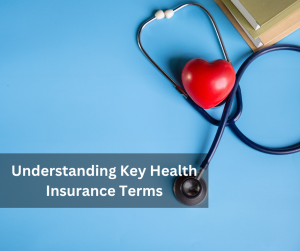
by admin | Jun 30, 2025 | Custom Content, Employee Benefits
 Selecting the right health insurance plans for your family is a critical process that requires careful attention from start to finish. Navigating health insurance becomes much simpler when you understand its terminology. Making sense of these terms empowers you to better understand your costs, benefits, and even estimate the price of a doctor’s visit.
Selecting the right health insurance plans for your family is a critical process that requires careful attention from start to finish. Navigating health insurance becomes much simpler when you understand its terminology. Making sense of these terms empowers you to better understand your costs, benefits, and even estimate the price of a doctor’s visit.
Premium: Your Insurance Payment: The premium is the regular payment you make to an insurance company to maintain your coverage. When you get insurance through your employer, they will specify how much of the premium you are responsible for, and this amount is typically deducted from your paycheck before your taxes are calculated.
Copayment : A copayment, often called a copay, is a specific amount you pay for a covered healthcare service, and it’s usually due when you receive that service. The amount of the copay can be different for different types of care.
Copay Example: For her son’s pediatrician visit for the flu, Heather had a $15 copay that she paid at the time of the appointment.
Deductible: A deductible is the amount you pay for healthcare services each year before your insurance starts covering costs.
Deductible Example: Ashley has a $1,000 annual deductible. Her first arm surgery costs $800. Since she hasn’t met her deductible yet, she pays the full $800.
Coinsurance: Coinsurance is the percentage of the allowed cost for a covered healthcare service that you’re responsible for paying after you’ve paid your deductible.
Coinsurance Example: Ashley’s next surgery costs $3,200 (the allowed amount). She has already paid $800 of the $1,000 deductible so she is responsible for the first $200 of the second surgery. Her insurance has an 80/20 coinsurance split. This means they pay 80% ($2,400), and Ashley pays 20% ($600).
Out-of-Pocket Maximum (OOPM): The OOPM is the maximum amount you’ll pay for covered healthcare costs in a year, not counting your monthly premium. It acts as a financial safety net against very expensive medical care. After you reach your yearly OOPM, your insurance pays 100% of covered costs for the rest of the year. Be aware that some plans have rules about what expenses count towards your OOPM; for instance, some might not include your deductible.
OOPM Example: Ashley has a $3,000 out-of-pocket maximum and has paid $1,600 so far. Her next surgery costs $8,000. She will pay her 20% coinsurance until her total out-of-pocket reaches $3,000. She has $1,400 left to pay. After that, her insurance covers the remaining $6,600.
Preventive Care: Preventive care focuses on staying healthy and catching illnesses early. It includes medical tests, vaccines, screenings, and medications designed to prevent chronic diseases. The goal is to identify and treat health issues in their most manageable stages. Under the Affordable Care Act (ACA), most health insurance plans must cover a range of preventive services without charging copays, deductibles, or coinsurance.
Preventive Care Example: Lori makes an appointment for her yearly check-up and a mammogram with a doctor in her network. Since these are preventive services covered by the ACA, Lori pays nothing – her health insurance covers the full cost.
Other Benefits Terminology
Pre-existing Condition: This is any health issue (physical or mental, including disabilities) you had before your health plan started. Since 2014, most insurers can’t deny coverage or charge more for pre-existing conditions, unless you have a “grandfathered” plan.
Grandfathered Plan: This is a health plan that existed before the ACA (2010) and hasn’t changed much since. These plans don’t have to follow all of the ACA’s rules.
Summary of Benefits and Coverage (SBC): The SBC is a straightforward document that outlines the costs and coverage of a health plan in an easy-to-compare format.
All those healthcare acronyms and terms might seem overwhelming but taking the time to learn them can put you in control. Understanding the lingo makes it easier to pick a health plan that meets your individual needs and budget!

by admin | Jun 24, 2025 | Human Resources
 Almost one-third of businesses or 31 percent are planning to invest in business intelligence and data analytics in the next 12 months, according to PEX Report 2024-25. Business intelligence dashboards are used by almost two-thirds of organizations with data visualization and process intelligence coming second and third respectively.
Almost one-third of businesses or 31 percent are planning to invest in business intelligence and data analytics in the next 12 months, according to PEX Report 2024-25. Business intelligence dashboards are used by almost two-thirds of organizations with data visualization and process intelligence coming second and third respectively.
“OPEX and transformative growth hinges on the strategic use of advanced data analytics and business intelligence,” Madhu Kittur, industry analyst, told PEX Network.
Clearly, data is a big deal nowadays. As HR Exchange Network prepares for the All Access: Digital Transformation in HR webinar series, data becomes one of the words in the word cloud. People analytics is necessary storytelling and allows HR leaders to validate their seat at the C-suite table. It provides a way to explain decisions and make informed decisions. With advanced technology helping humans more easily gather disparate data and make sense of it, the data becomes currency.
Recently, HR Exchange Network spoke with Michael D. Lieberman People Analytics: Statistical Case Studies for Human Resources (independently published, August 2024), who reminds people that getting down to the basics of data analytics is vital to everyone’s success. Discover his ideas:
HREN: Why should professionals entering HR analytics learn basic statistics?
ML: Statistical literacy is essential for making informed HR decisions. HR analytics tools require a solid foundation in statistics to interpret data effectively. Without understanding the basics, it’s difficult to properly analyze workforce data or make evidence-based decisions about employee programs.
HREN: What techniques are commonly used in HR analytics and why were they chosen?
ML: Many techniques used in HR analytics were adapted from marketing research. The focus should be on desired outcomes rather than specific techniques. Regression analysis and sequence waiting are particularly useful for analyzing employee benefits and performance metrics. The key is selecting methods that answer your specific business questions.
HREN: What advice would you give to beginners in HR analytics to avoid feeling overwhelmed?
ML: Take a step back to understand the question and desired outcome before diving into data. Know what event you’re analyzing and what insights you’re trying to gain. Think of analytics as storytelling with numbers – you’re using data to convey insights that drive decisions.
HREN: How can HR professionals approach changing performance review systems?
ML: Consider testing different types of performance reviews or adding new elements to your existing system. Apply design thinking principles to statistical modeling, making it an iterative process of refining ideas based on feedback and results.
HREN: How is people analytics relevant to the broader business?
ML: Happier employees lead to more profitable businesses. HR analytics helps maximize efficiency by understanding and minimizing costs related to turnover, onboarding, and other HR expenses. This data-driven approach allows HR leaders to make stronger business cases for people-focused initiatives.
HREN: What final advice would you give to HR professionals about analytics?
ML: There’s tremendous momentum in the people analytics industry right now. HR professionals should develop data fluency to make better decisions and communicate more effectively with leadership. Balance soft skills with data literacy – both are necessary for success in modern HR.
By Francesca Di Meglio
Originally posted on HR Exchange Network

by admin | Jun 10, 2025 | Custom Content, Employee Benefits
 The word “cancer” carries a weight that extends far beyond its medical implications. Beyond the physical and emotional toll, a cancer diagnosis can bring significant financial strain. While your primary health insurance will cover many treatment costs, there are often substantial out-of-pocket expenses that can quickly add up. This is where cancer insurance comes in. But what exactly is it, and how does it work?
The word “cancer” carries a weight that extends far beyond its medical implications. Beyond the physical and emotional toll, a cancer diagnosis can bring significant financial strain. While your primary health insurance will cover many treatment costs, there are often substantial out-of-pocket expenses that can quickly add up. This is where cancer insurance comes in. But what exactly is it, and how does it work?
What is Cancer Insurance?
Cancer insurance is a type of supplemental health insurance policy designed to provide financial assistance specifically if you are diagnosed with cancer. It’s not a substitute for comprehensive health insurance but rather an additional layer of protection to help manage the costs associated with cancer treatment and recovery. These policies typically pay out a lump-sum benefit or provide ongoing payments upon a cancer diagnosis that meets the policy’s definition.
Think of it as a financial safety net tailored to the unique challenges of battling cancer. The funds received from a cancer insurance policy can be used for a variety of expenses that your primary health insurance might not fully cover, such as:
- Deductibles and Coinsurance: Even with good health insurance, you’ll likely have deductibles and coinsurance amounts to pay.
- Lost Income: If you or your caregiver need to take time off work for treatment and recovery, it can lead to a significant loss of income.
- Travel and Accommodation: Traveling to specialized treatment centers can incur substantial costs for transportation, lodging, and meals
- Experimental Treatments: Some cutting-edge or experimental treatments may not be fully covered by standard health insurance.
- Other Living Expenses: The financial burden of cancer can extend to everyday expenses like groceries, utilities, and transportation.
How Does It Work?
- Purchase a Policy: You buy a cancer insurance plan through an insurer, often as an add-on through your employer or directly as an individual.
- Pay Monthly Premiums: Like other insurance policies, you’ll pay a regular premium to maintain coverage.
- Get Diagnosed: If you’re diagnosed with cancer while your policy is active, you file a claim. Cancer insurance will generally only pay benefits for the first occurrence of cancer and will not provide benefits if you have already been diagnosed before purchasing the insurance.
- Receive Benefits: Depending on your policy, you may receive a lump sum or payments for specific treatments and services.
While no one wants to imagine facing cancer, being prepared can make a significant difference. Cancer insurance helps reduce the financial stress of a diagnosis, allowing you to focus more on recovery and less on expenses. However, it’s essential to review your current health coverage and weigh whether supplemental cancer insurance fits your needs and budget.

by admin | Jun 2, 2025 | Compliance
 The annual EEO-1 Report, mandated by the Equal Employment Opportunity Commission (EEOC), is a cornerstone of workplace diversity and anti-discrimination efforts in the United States. This data collection provides a demographic snapshot of America’s workforce, helping to monitor for discrimination and promote equal employment opportunity. Missing the deadline can lead to serious consequences, making it imperative for eligible employers to understand the reporting requirements and act promptly.
The annual EEO-1 Report, mandated by the Equal Employment Opportunity Commission (EEOC), is a cornerstone of workplace diversity and anti-discrimination efforts in the United States. This data collection provides a demographic snapshot of America’s workforce, helping to monitor for discrimination and promote equal employment opportunity. Missing the deadline can lead to serious consequences, making it imperative for eligible employers to understand the reporting requirements and act promptly.
Who Must File?
Generally, the following employers are required to file an annual EEO-1 Component 1 report:
Private sector employers with 100 or more employees during an employer-selected payroll period (workforce snapshot period) in the fourth quarter (October 1 through December 31) of the reporting year.
Federal contractors and first-tier subcontractors with 50 or more employees and a contract, subcontract, or purchase order amounting to $50,000 or more, or who serve as a depository of Government funds in any amount, or act as an issuing and paying agent for U.S. Savings Bonds and Notes.
It’s crucial to note that even if an employer has fewer than 100 employees during the selected snapshot period, they may still be required to file if their total employee count reached 100 or more at any point during the fourth quarter of the reporting year, or if they are affiliated with a parent company that meets the 100-employee threshold.
The All-Important Deadline: June 24, 2025 (for 2024 data)
For the 2024 EEO-1 Component 1 report, the data collection period opened on May 20, 2025, and the deadline to submit and certify reports is Tuesday, June 24, 2025, at 11:00 PM ET.
This year, the EEOC has emphasized a shorter collection period compared to some previous cycles. This means employers have a more condensed window to gather their data, review for accuracy, and submit their reports through the EEO-1 Component 1 Online Filing System (OFS).

by admin | May 28, 2025 | Custom Content
 Your most valuable asset isn’t your house, car or retirement account. It’s the ability to make a living. Long-term disability insurance (LTD) provides financial protection by replacing a portion of your income—typically 50% to 70%—if you become unable to work due to a prolonged illness, injury, or accident. This benefit is paid directly to you and you determine how best to use this income replacement. It serves as a critical safety net for sustaining essential expenses like housing, medical bills, and daily living costs during extended recovery periods.
Your most valuable asset isn’t your house, car or retirement account. It’s the ability to make a living. Long-term disability insurance (LTD) provides financial protection by replacing a portion of your income—typically 50% to 70%—if you become unable to work due to a prolonged illness, injury, or accident. This benefit is paid directly to you and you determine how best to use this income replacement. It serves as a critical safety net for sustaining essential expenses like housing, medical bills, and daily living costs during extended recovery periods.
Benefits consultants agree that although long-term disability coverage lacks the novelty appeal of some other benefits that companies are offering these days (Hello, pet insurance!) but it can prove much more valuable in the long run. After all, according to the Social Security Administration, 1 in 4 people who are 20 years old now will be disabled before they reach age 67.
How It Works
- Enrollment and Premiums: You can often obtain LTD insurance through your employer as part of a group benefits package or purchase an individual policy. You will typically pay a monthly premium to keep the coverage active. Employer-sponsored plans may be more cost-effective (think of it as buying in bulk), but individual policies offer more customization and portability.
- Elimination Period: Before benefits begin, there is a waiting period called the “elimination period.” This period can range from a few months to a year, depending on your policy. Short-term disability insurance may cover this initial period.
- Benefit Payments: Once the elimination period is over and your claim is approved, you will receive monthly benefit payments. The amount is typically a percentage of your pre-disability income, often ranging from 50% to 70%.
- Benefit Duration: The length of time you receive benefits depends on your policy’s terms. Some policies pay benefits for a specific number of years (e.g., 5, 10 years), while others continue until you reach retirement age or recover from your disability.
- Definition of Disability: LTD policies have a definition of disability that you must meet to be eligible for benefits. Many policies have an “own occupation” definition for an initial period (e.g., 24 months), meaning you are considered disabled if you cannot perform the essential duties of your regular job. After this period, the definition may switch to “any occupation,” meaning you must be unable to perform any job that you are reasonably qualified for based on your education, training, and experience.
What Does LTD Insurance Cover?
When most people think of disabilities, they imagine catastrophic workplace accidents resulting in lost limbs. The reality is far less dramatic. Every day people are diagnosed with common illnesses and injuries that prevent you from working, including:
- Physical Injuries: Severe back injuries, joint pain, loss of limb.
- Illnesses: Cancer, heart disease, diabetes, multiple sclerosis.
- Mental Health Conditions: Depression, anxiety, and other mental health disorders (though some policies may have limitations on benefits for these conditions).
- Neurological Disorders: A Stroke, Parkinson’s disease, ALS.
It’s important to review your specific policy to understand what conditions are covered and any exclusions that may apply.
Key Considerations When Choosing LTD Insurance:
- Benefit Amount: Determine how much of your income would need to be replaced to meet your financial obligations.
- Elimination Period: Consider how long you can go without income before benefits begin.
- Benefit Duration: Think about how long you might need income replacement if you become disabled.
- Definition of Disability: Understand the policy’s definition of disability and how it may change over time.
- Portability: If you obtain insurance through your employer, consider what happens if you change jobs. Individual policies are typically portable.
Long-term disability is only designed to replace a portion of your income – it doesn’t cover extra expenses like your medical bills or long-term care costs. Remember: LTD isn’t there to make you rich – it’s there to pay the bills and put food on the table if something happens to you.

 Selecting the right health insurance plans for your family is a critical process that requires careful attention from start to finish. Navigating health insurance becomes much simpler when you understand its terminology. Making sense of these terms empowers you to better understand your costs, benefits, and even estimate the price of a doctor’s visit.
Selecting the right health insurance plans for your family is a critical process that requires careful attention from start to finish. Navigating health insurance becomes much simpler when you understand its terminology. Making sense of these terms empowers you to better understand your costs, benefits, and even estimate the price of a doctor’s visit.



